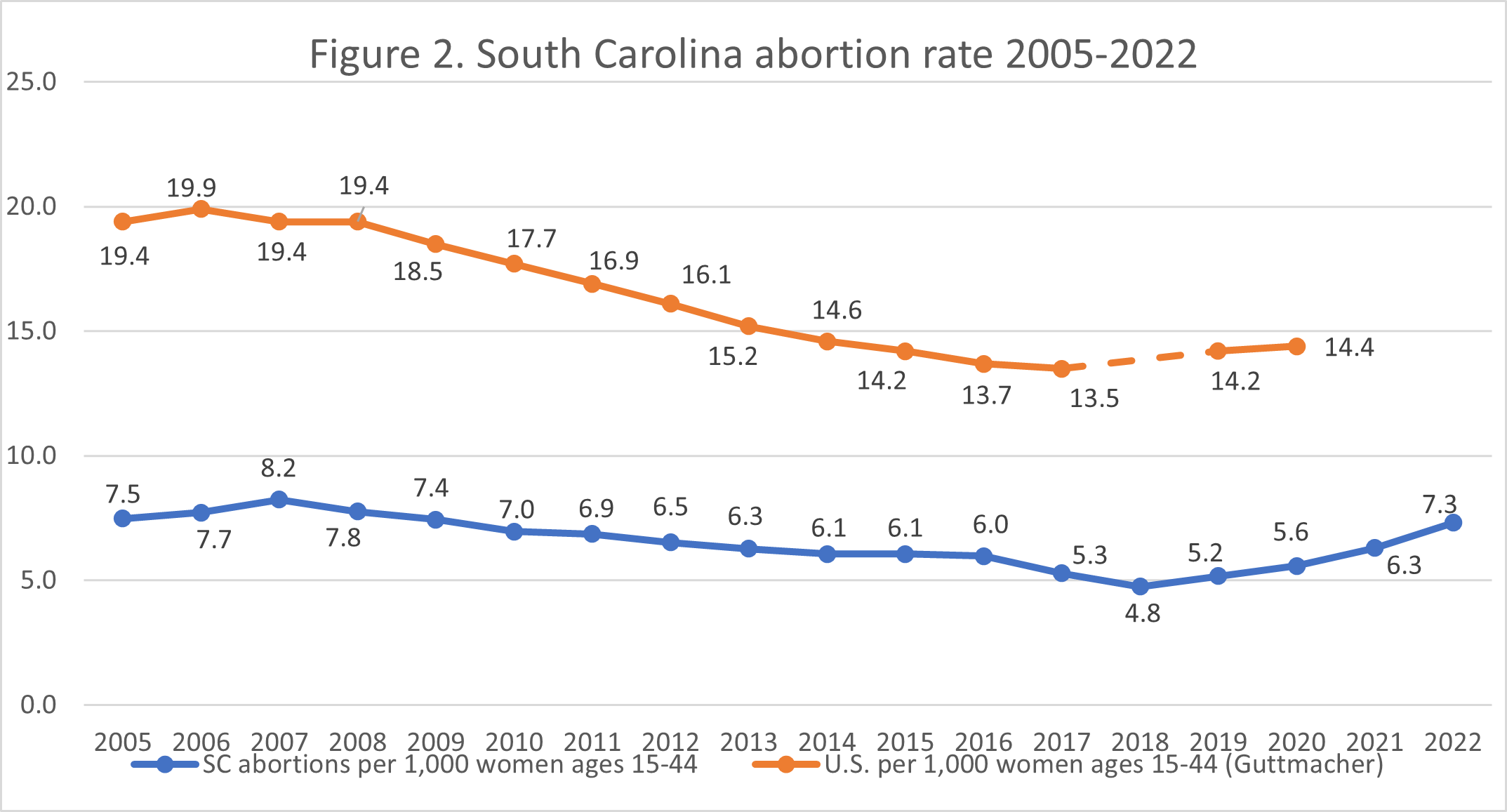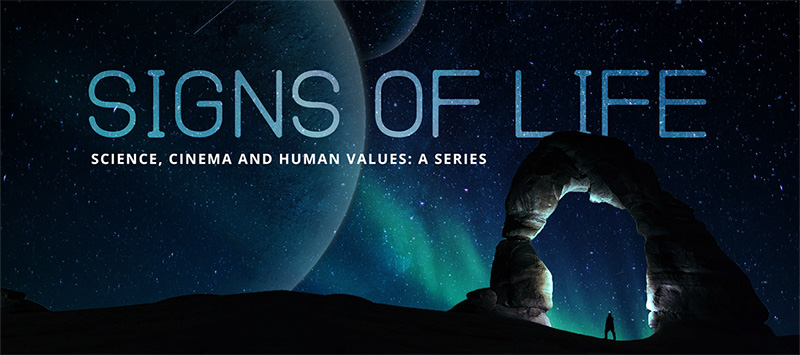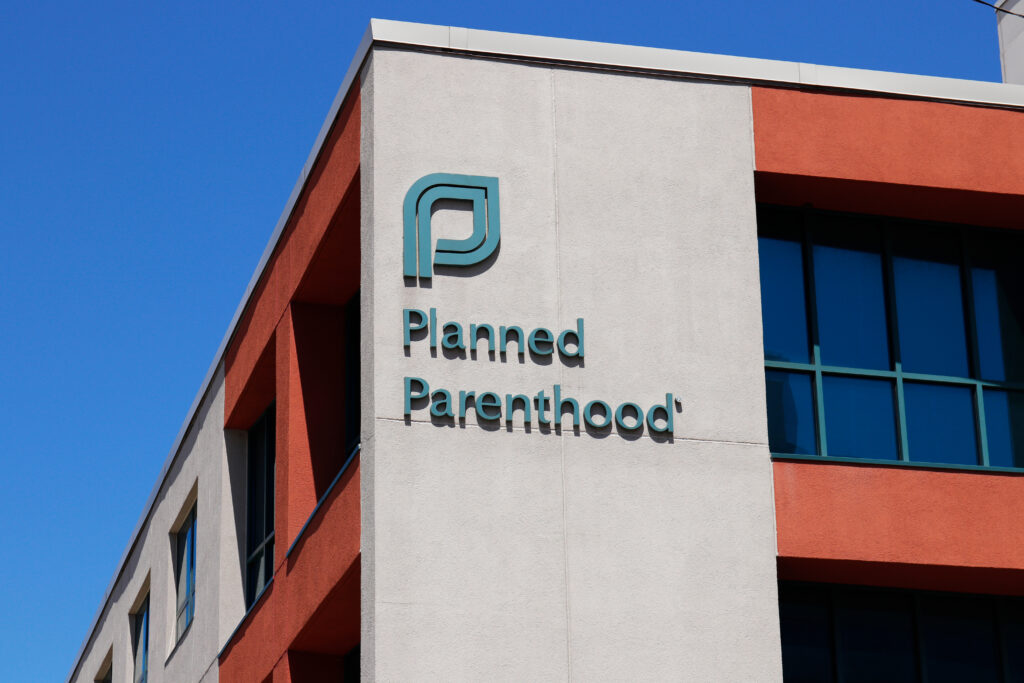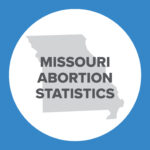Abortion Reporting: South Carolina (2022)
South Carolina’s 2022 abortion report was published in June 2023. The report revealed that abortions increased in 2022 from 2021.
Statistics and Changes in South Carolina Abortions, 2021-2022

This report does not include information on South Carolina’s Planned Parenthood market share.
Abortion Totals and Trends
In 2022, there were 7,276 abortions reported in South Carolina, up 16 percent from the previous year (Fig. 1). Chemical abortions, which made up 72 percent of abortions reported in the state, increased by 13 percent from 4,623 in 2021 to 5,217 in 2022. The Charlotte Lozier Institute (CLI) estimates that South Carolina’s abortion rate was 7.3 abortions per 1,000 women of childbearing age, an increase of 16 percent from the previous year (Fig. 2).1 As of August 2023, 17 states have released 2022 abortion statistics, 12 of which showed that abortions had increased from 2021.
State Report Summary
Over half (57 percent) of the abortions reported in South Carolina in 2022 were performed on women in their twenties, with 28 percent on women ages 20 to 24 and 29 percent on women ages 25 to 29. Twenty percent of the abortions were obtained by women ages 30 to 34, while 14 percent were on women ages 35 and older. Nine percent of the abortions were performed on girls who were 19 or younger, including 78 on girls ages 15 to 16 and 19 on girls who were 15 and younger.
Just under three-quarters of South Carolina abortions (72 percent) were chemical. Nineteen percent were electrical vacuum aspiration procedures, and seven percent were performed using dilation and curettage. Two percent of the abortions were performed using manual vacuum aspiration, and less than one percent were dilation and evacuation abortions. There were seven prostaglandin induction abortions.
South Carolina also reported on the age of babies killed by abortion in 2022. Post-fertilization age measures pregnancy from the date of fertilization, and is typically two weeks less than gestational age, which measures pregnancy from the first day of the last menstrual period. Fifty-one percent of the abortions in South Carolina were performed at six weeks post-fertilization or earlier, and 48 percent were performed between seven and 13 weeks. Less than one percent of South Carolina abortions were reported after 13 weeks post-fertilization. There were 34 abortions (0.5 percent) between 14 and 19 weeks, and five between 20 and 23 weeks post-fertilization.
In 2022, South Carolina limited abortion to 20 weeks post-fertilization unless the baby had an abnormality that he or she was unlikely to survive, or if the mother’s life or a major bodily function was at risk. If an abortion at 20 weeks was performed, the doctor was obligated to use the type of abortion procedure that would give the unborn baby the best chance at survival, unless doing so would put the mother’s life or major bodily function at increased risk. The law also specified that, unless a medical emergency existed or the unborn baby had an abnormality, post-fertilization age must be determined before every abortion. In light of this law, ultrasound was used to determine post-fertilization age in advance of all but three South Carolina abortions (99.9 percent).
There were five abortions performed at 20 weeks post-fertilization or later. Two were performed due to a medical emergency, and three were performed because the unborn babies had anomalies. For three of the abortions, the procedure that would give the unborn baby the best chance of survival was used; a different procedure was used for two abortions.
For two abortions, an intra-fetal injection was used to kill the unborn baby. The report does not indicate the gestational ages of the two abortions that used an intra-fetal injection.
Legislative Changes
As CLI has previously summarized, South Carolina’s 2021 heartbeat law went into effect in June 2022 but was blocked by a court order in early August of that year. The South Carolina legislature considered another heartbeat bill in 2022, which ultimately did not pass.
In 2023, the South Carolina legislature passed a new heartbeat law, S474, that contains exceptions for the life and physical health of the mother, cases of rape and incest, and anomalies in the unborn baby. The rape and incest exceptions apply only to pregnancies before 13 weeks gestation. The bill was signed into law by Governor Henry McMaster on May 25, 2023, and went into effect immediately. However, the law was blocked the next day by a circuit court judge. The law is not in effect while litigation continues, and abortion continues to be legal in the state up until 22 weeks gestation (approximately 20 weeks post-fertilization).
State Ranking
In 2016, CLI reviewed abortion reporting across the 50 states, New York City, and the District of Columbia, and South Carolina was ranked 28th best. To strengthen their reporting, South Carolina could report the race, level of education, and marital status of all women getting abortions in the state. The state could also collect and report information on complications resulting from abortion.


- National rates were calculated by Guttmacher Institute. South Carolina rates were calculated by CLI using the following formula: (total number of abortions performed in South Carolina ÷ number of resident women ages 15-44 [based on most recent population estimates]) x 1,000. Rates may differ slightly from previous CLI articles due to revised population estimates. Population estimates were obtained from the CDC WONDER database. Estimates for 2005-2009 are intercensal estimates of the July 1 resident population. Estimates for 2010-2019 are Vintage 2020 postcensal estimates of the July 1 resident population. Estimates for 2020-2022 are Vintage 2021 postcensal estimates of the July 1 resident population as the CDC has not yet released 2022 population estimates. Estimates were produced by the U.S. Census Bureau and the National Center for Health Statistics.
- Abortion totals prior to 2017 are from the CDC. South Carolina did not report its chemical abortion total to the CDC in 2005.
Click here to view reporting from:2023202120202019201820172016























